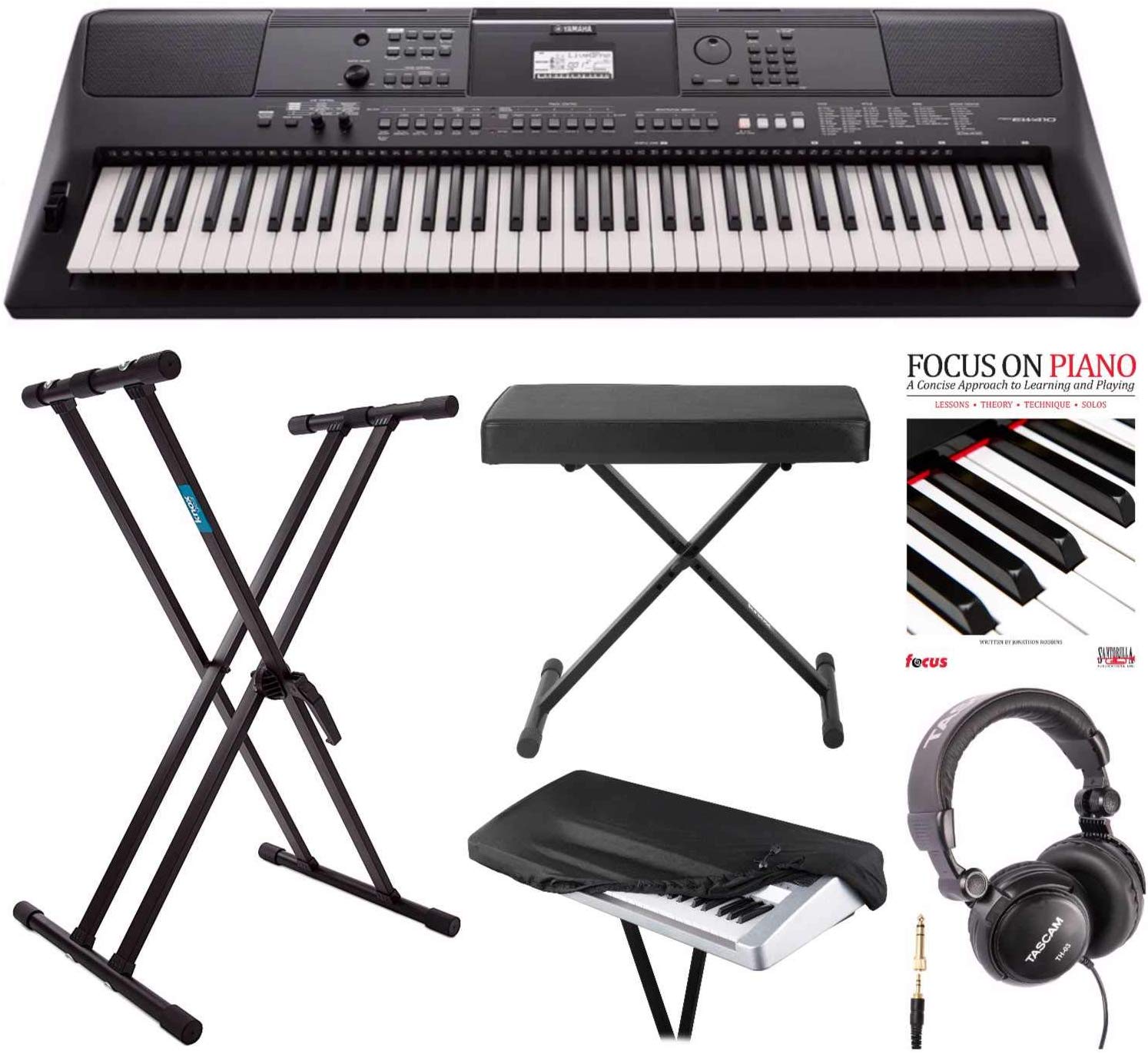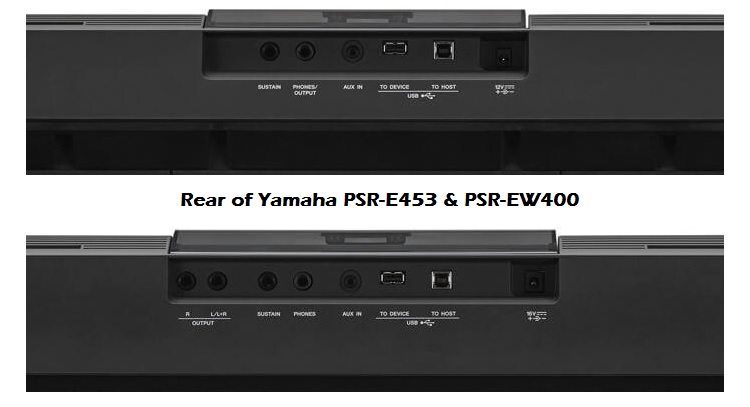
Please click image for more info
The 76-key keyboard occupies an interesting niche among piano players. For some, it is a more advanced instrument and an upgrade from their beginner 61-key keyboard. For professionals, it’s often a step down from a full-size keyboard, to have a more portable instrument for gigs and travel. And for some digital musicians and DJs, a 76-key keyboard may be all they ever need.
In short, a keyboard of this size occupies a middle ground that may be too small, may be too large, and may be just perfect. And, for a surprising number of musicians, the Yamaha PSR-EW410 is the Goldilocks of keyboards: it’s just right.
Overview of Yamaha PSR-EW410

Yamaha has designed the PSR-EW410 as a mid-level keyboard. It is designed and marketed toward intermediate beginners who have outgrown a small, 61-key keyboard, and are ready for the more advanced digital features and touch sensitivity of the PSR-EW410.
However, the PSR-EW410 is limited by its interface. It has an incredible range of features and capabilities, and incredible sound, for the price. But you can only access and control these features and settings by navigating the little LCD screen and pressing a lot of buttons. The process of accessing the vast onboard database of hundreds of voices, hundreds of styles, and dozens of individual features and settings, can try the patience of early players and lessen the enjoyment of using this incredible instrument.
In other words, the Yamaha PSR-EW410 packs incredible value into a compact footprint, but may be a bit tedious to work with. It’s not a beginner’s instrument.
Yamaha PSR EW410 Video Overview
Yamaha PSR-EW410 FAQs
When did the Yamaha PSR-EW410 come out?
The Yamaha PSR-EW410 came out in 2018
What are the dimensions of the Yamaha PSR-EW410?
The dimensions of the Yamaha PSR-EW410 are as follows:
- Width 1,179 mm (46-3/8”)
- Height 138 mm (5-7/16”)
- Depth 413 mm (16-1/4”)
What is the weight of the Yamaha PSR-EW410?
The Yamaha PSR-EW410 weighs 8.4 kg (18 pounds, 8 ounces) excluding the batteries.
How much does the Yamaha PSR-EW410 cost?
The current price of the Yamaha PSR-EW410 is around $430, but price can vary depending on where you buy it and if you buy a “bundle” that includes a stand and other accessories.
How many keys does the Yamaha PSR-EW410 have?
The Yamaha PSR-EW410 has 76 keys.
How many sounds does the Yamaha PSR-EW410 have?
The Yamaha PSR-EW410 has a total of 758 sounds.
Where can I see a demo/test of the Yamaha PSR-EW410?
You can see a demo of the Yamaha PSR-EW410 on the official Yamaha channel on YouTube: Yamaha PSR-EW410 demo
Where can I see an unboxing of the Yamaha PSR-EW410?
You can see an unboxing here: Yamaha PSR-EW41a0 unboxing
Where to buy the Yamaha PSR-EW410?
To get the best price on a Yamaha PSR-EW410 check on Amazon.
How many tracks can you record on a Yamaha PSR EW410?
A Yamaha PSR EW410 can record 6 tracks (5 Melody + 1 Style/Groove Creator)
Yamaha PSR EW410 vs EW400
The similarities between Yamaha PSR EW410 and EW400 are more than the differences. Some of their notable similarities are:
- Both models have 76 keys.
- They have total 758 sounds and maximum 48 polyphony each.
- Both models have connections of auxiliary audio input, headphone output and sustained pedal input.
- They can record 6 tracks.
- Both models have 12W + 12W amplifiers with 12 cm Bass Reflexed speakers.
Their differences are:
- The PSR EW410 has a higher number of rhythms, 235, versus 220 rhythms in the PSR EW400.
- The PSR EW400 does not have the Groove Creator function, although it does have the “DJ Patterns” function which is very similar.
- The PSR EW400 does not have the Quick Sampling feature that allows you to create new voices from recorded samples.
- Dimension of PSR EW410 is 51.9 x 19.15 x 9.5″ but EW400 has 46.25×16.25 x 5.5″.
Yamaha PSR EW410 vs DGX 660
The current price of the Yamaha DGX 660 (~$800) is nearly double of that of PSR EW410 (~$430).
Having said that, these two models have the following things in common:
- The keyboards have 3 levels of sensitivity plus fixed touch response.
- Both have maximum audio recording time of 80 minutes per song
- Both Yamaha PSR EW410 and DGX 660 have same reverberation and chorus.
- Both models have connections of auxiliary audio input, headphone output and sustained pedal input
The notable differences between the Yamaha PSR EW410 and DGX 660 are:
- Keyboard: Yamaha PSR EW410 has 76 keys but DGX 660 has total 88 Keys.
- Yamaha PSR EW410 has a dimension of 46.4 x 5.4 x 16.3″ (1179 x 138 x 413 mm) and weighs 18.5 pounds (8.4 kg without Batteries). DGX 660 has a larger dimension of 55 x5.8 x 17.6″ (1397 x 146 x 445 mm without Stand) and 55.1 x 30 x 17.6″ (1399 x 761 x 445 mm with Stand). It weighs 46.4 pounds (21 kg without Stand) and 61.7 pounds (28 kg with Stand)
- Number of Sound Presets: Yamaha PSR EW410 has 758 presets but DGX 660 has total 539 presets and extra 15 drum kits.
- Number of Song Presets: Yamaha PSR EW410 has 10 user and 30 factory song presets. On the other hand DGX 660 has 100 factory and 6 user song presets.
- Maximum Polyphony: Yamaha PSR EW410 has 48 polyphonic voices or notes but DGX 660 has 192 notes.
- PSR EW410 has one touch and multi-finger setting function but DGX 660 has one touch auto chord.
- PSR EW410 has 2 x 12 W amplifiers and DGX 660 has 2 x 6 W amplifiers but both of them uses same round speakers (2 x 4.7″ / 12 cm)
- DGX 660 has a separate stand.
Yamaha PSR EW410 vs Casio WK 7600
The Casio WK 7600 costs a bit more than Yamaha PSR EW410, and they have quite different features.
First, here are the similarities between the two models:
- Both the keyboards have total 76 keys each.
- Both of them have same size of speakers.
- They use 6 x D type batteries.
Their main differences are:
- Yamaha PSR EW410 has level 3 sensitivity but Casio WK 7600 has level 2 sensitivity.
- Yamaha PSR EW410 has 758 preset sounds and Casio WK 7600 has 820 preset sounds.
- Yamaha PSR EW410 has 10 users and 40 factory preset songs but Casio WK 7600 has 5 user preset songs.
- There are 235 preset style in Yamaha PSR EW410 which isn’t applicable for Casio WK 7600.
- Yamaha PSR EW410 has only 35 rhythm presets but Casio WK 7600 has total 360 rhythm presets
- The one-touch setting function is only applicable for Yamaha PSR EW410.
- Though both models support General MIDI but Yamaha PSR EW410 also supports XGlite.
- Yamaha PSR EW410 can record maximum 80 minutes per songs which isn’t applicable for Casio WK 7600.
- PSR EW410 has 2 x 12 W amplifiers and Casio WK 7600 has 2 x 7 W amplifiers.
- PSR EW410 has a dimension of 46.4 x 5.4 x 16.3″ (1179 x 138 x 413 mm) and weighs weighs 18.5 pounds (8.4 kg without Batteries). On the other hand Casio WK 7600 has dimension of 46.7 x 15.7 x 5.9″ (1186 x 399 x 150 mm) and weighs 19.6 pounds (8.9 kg).
Yamaha PSR EW410 Specs
|
Specification |
Description |
|---|---|
|
Keys |
76 touch-responsive keys |
|
Weight |
Weighs slightly over 18 pounds without batteries |
|
Display |
LCD display |
|
Songs |
154 preset songs, including touch tutor, chord study, and chord progression practice songs |
|
Reverb Settings |
12 types of reverb5 types of chorus |
|
Polyphony |
48 max levels of polyphony |
|
Style Control |
235 preset styles with style control, and 10 external styles |
|
Harmony |
26 types of harmony 26 types of harmony |
|
Voice & Effects |
758 total instrument voices, with 237 panel voices, 25 drums and effects, 40 arpeggio, and 457 XGlite voices. |
|
Functions |
– Dual and split keyboard functions- Melody suppressor function- Crossfade function- Transpose, tuning, and scale functions |
|
Jacks & Ports |
– Sustain pedal jack- USB to host and USB to device ports supports MIDI files- Headphone jack- AUX IN stereo mini jack |
|
Record and Playback |
Record and playback up to 10 songs with 6 tracks as WAV files |
|
Music Database |
30 preset song library |
|
Power |
Can be battery powered with 6 D batteries |
|
Metronome |
Yes |
|
Others |
– 10 types of DSP, assignable to control knobs- 6 types of Master EQ- 150 types of built in arpeggio- Groove creator with 35 preset grooves and 5 sections- One Touch Setting – Portable Grand Piano button- Quick sampling, with 3 types and 7 presets- Pitch bend knob |
Yamaha PSR-EW410 Features
The Yamaha PSR-EW410 has a huge range of features and capabilities for its price tag.
|
FEATURE |
DESCRIPTION |
|---|---|
|
Design |
The Yamaha PSR-EW410 weighs just over 18 pounds without batteries and measures approximately 46 x 16 x 5 inches. It’s at the larger end of portable keyboards, but can still be easily taken to gigs, lessons, events, parties, and performances. It has 76 keys with 3 levels of touch response, or turn off touch response altogether. The onboard buttons and menus are clearly labeled, and LCD screen is easy to read as it guides you through settings and functions. |
|
Sound |
The Yamaha PSR-EW410 is driven by the Yamaha AWM stereo sampling sound engine, and has two onboard 12 watt amplifiers and two 12 cm speakers. It has an impressive 758 total instrument voices, with 2377 panel voices, 24 drums and effects, 40 arpeggio, and 457 XGlite voices for a huge range of sound capabilities. With 235 styles preset, it has all you need to learn and play nearly any type of music. It has a large range of chorus, reverb, harmony, and EQ settings for modifying your sound, and 48 levels of polyphony which allow for complex, overlapping, nuanced music. You can also take advantage of the ability to record 7 samples of 9.6 seconds each, with 3 sampling types. |
|
Functions |
The PSR-EW410 has pitch bend and control knobs. It also has duo and split keyboard functions, so you can produce multiple instrument voices with every touch. One Touch Setting, Registration buttons, and Grand Piano button allow you to not only modify your settings as you prefer, but quickly store and save them, or immediately return to the factory default with Grand Piano. Transpose and tuning functions allow you to adjust the instrument to your preference, particularly when playing along with other instruments or vocalists. |
|
Connectivity |
The Yamaha PSR-EW410 has headphone and pedal jacks, including an AUX IN to connect a music player, and USB to host and USB to device ports for connection to computers and mobile devices. |
|
Features |
A library of 235 musical styles and style controls, including auto fill and other options, allows you to explore any music style you choose. Built-in arpeggio and a number of arpeggio styles and options adds even more capabilities for musical styles and sounds. The Melody Suppressor feature can suppress the vocals on tracks when they are played through the keyboard, allowing you to play or sing along without competition. |
Who the Yamaha PSR-EW410 most suitable for?

While the Yamaha PSR-EW410 may be an instrument designed for advanced beginners, it is actually an incredible instrument for DJs. The ability to sample, interface with MIDI devices, and record and playback are ideal for digital musicians. Onboard Yamaha grooves, the pitch bend feature, and 235 accompaniment styles are ideal for DJs and gig musicians.
Digital musicians and DJs will love the incredible array of capabilities built into this compact, portable, affordable keyboard. It has a great sound engine, and onboard speakers and amplifiers deliver great sound, or connect external speakers for more powerful audio. USB connectivity lets you record, sample, mix, and share your music with fans around the world.
What’s included with the Yamaha PSR-EW410
The Yamaha PSR-EW410 “Keyboard only” bundle doesn’t even come with the power supply. You will need to choose a bundle that includes the power supply, or buy it separately.
Additional Accessories

Accessory bundle: For a complete setup for the Yamaha PSR-EW410, consider the amazing bundle offered by Yamaha on Amazon.
This package includes:
-
The Yamaha PSR-EW410 keyboard
-
A Yamaha power adapter for the keyboard
-
A double X style keyboard stand
-
An X style keyboard bench
-
A keyboard dust cover
-
A pair of closed-back over-ear headphones
-
A piano learning lesson system
It’s a great value for a complete keyboard setup out of the box, with nothing additional to buy.
Headphones

Whether you are practicing at home, or playing a gig, headphones are an essential accessory for this keyboard. If you aren’t purchasing a bundle, a great option is the AKG M220 Pro DJ headphones. The semi-open style gives you clear, spacious sound and lets you monitor your music without completely excluding environment sounds. These headphones offer fantastic sound in their price range, and come with adapters to use with a variety of digital and analogue audio devices.
Subwoofer
The Yamaha KS-SW100 subwoofer is an extremely popular accessory for the PSR-EW410 keyboard. It has great clarity and tight bass in a compact, stylish speaker. It’s a must-have to fill in the full spectrum of sound in your music, and is built to bring out the best in the PSR-EW410.

Yamaha PSR-EW410 Pros and Cons
|
PROS |
|---|
|
|
cons |
|---|
|
Yamaha PSR-EW410 Owner’s manual
The owner’s manual and reference sheets are available directly from Yamaha, and can be found here:
CLICK TO DOWNLOAD YAMAHA PSR-EW410 MANUAL
Yamaha PSR-EW410 vs. Yamaha PSR-EW300

There are minor differences between the PSR-EW410 and the PSR-EW300. The PSR-EW 300 is a little smaller, a little lighter, has a slightly smaller library of voices and styles, and so forth. The biggest difference between these two keyboards is that the PSR-EW300 is made for beginners and students, and the PSR-EW410 is made for DJs and gig musicians. The Yamaha PSR-EW300 has a larger onboard song library (154 instead of 30), duo keyboard function, and an onboard lesson system. It has much weaker amplifiers, half the recording capacity, no USB to device port, no pitch bend or Live Control knobs, and doesn’t have the Yamaha Groove Creator. It’s also a much more affordable keyboard. For a beginner to the piano, or for a player who is more interested in exploring the classic grand piano sound of the Yamaha AWM sound engine, the PSR-EW300 is a great choice. It has all the features and capabilities you need to play beautiful piano. However, if you want to sample, record, mix, and share music, the PSR-EW410 is designed for you.
YAMAHA PSR-EW410 Tutorial
Groove Creator On The YAMAHA PSR-EW410
Conclusion
For a digital musician who wants fantastic sound and a huge range of digital capabilities in an affordable, portable keyboard, it’s hard to beat the Yamaha PSR-EW410. It will take time and study of the manual and online tutorials to learn how to quickly access and take advantage of all the features of this keyboard, but it pays off in great grooves, great tunes, and the ability to connect your keyboard to a wide range of USB-driven external devices.
For musicians who are just learning, or who are more interested in a keyboard that provides a great piano experience, the Yamaha PSR-EW410 may be more keyboard than you need. You can still get all that fantastic sound at a lower price with the PSR-EW300 or other classic Yamaha keyboards.
The Yamaha PSR-EW410 is a versatile mid-range keyboard for a wide range of needs and players.

Yamaha PSR EW410 (click image for more info)
It’s not the perfect keyboard for everyone; some pros find it a bit too limiting; some beginners find it a bit too advanced. But for those people who want a 76-key keyboard with digital capabilities and superior sound in a portable, affordable package, this keyboard is hard to beat.

